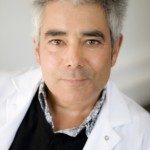Link to Pubmed [PMID] – 29659565
PLoS Genet. 2018 Apr;14(4):e1007342
Cyclic nucleotides are universally used as secondary messengers to control cellular physiology. Among these signalling molecules, cyclic di-adenosine monophosphate (c-di-AMP) is a specific bacterial second messenger recognized by host cells during infections and its synthesis is assumed to be necessary for bacterial growth by controlling a conserved and essential cellular function. In this study, we sought to identify the main c-di-AMP dependent pathway in Streptococcus agalactiae, the etiological agent of neonatal septicaemia and meningitis. By conditionally inactivating dacA, the only diadenyate cyclase gene, we confirm that c-di-AMP synthesis is essential in standard growth conditions. However, c-di-AMP synthesis becomes rapidly dispensable due to the accumulation of compensatory mutations. We identified several mutations restoring the viability of a ΔdacA mutant, in particular a loss-of-function mutation in the osmoprotectant transporter BusAB. Identification of c-di-AMP binding proteins revealed a conserved set of potassium and osmolyte transporters, as well as the BusR transcriptional factor. We showed that BusR negatively regulates busAB transcription by direct binding to the busAB promoter. Loss of BusR repression leads to a toxic busAB expression in absence of c-di-AMP if osmoprotectants, such as glycine betaine, are present in the medium. In contrast, deletion of the gdpP c-di-AMP phosphodiesterase leads to hyperosmotic susceptibility, a phenotype dependent on a functional BusR. Taken together, we demonstrate that c-di-AMP is essential for osmotic homeostasis and that the predominant mechanism is dependent on the c-di-AMP binding transcriptional factor BusR. The regulation of osmotic homeostasis is likely the conserved and essential function of c-di-AMP, but each species has evolved specific c-di-AMP mechanisms of osmoregulation to adapt to its environment.




